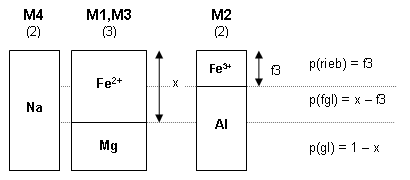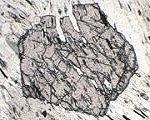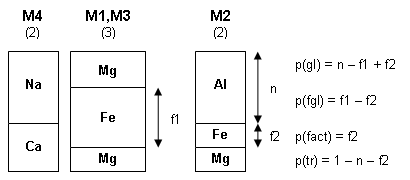Practical Aspects of Mineral Thermobarometry
Activity coding for Na-amphibole
Four-component NCFMASH amphibole
This provisional coding for sodic amphiboles (18 Aug 2003) expresses them in the quadrilateral gl-fgl-tr-fact. There are separate terms for the Fe content of the M1/M3 and M2 sites - it seems to work OK. The fictive Ca-amphibole end members are given relatively large DQF increments, following Carson et al., 1999, Journal of Metamorphic Geology, 17, 9-24. These restrict the Ca content of sodic amphibole, and could be adjusted to match well-characterised natural compositions.
nam 4
n(nam) 0.8 % Na/(Na+Ca)
f1(nam) 0.3 % XFe in M13
f2(nam) 0.05 % XFe in M2
p(gl) 1 1 0 3 1 n -1 f1 1 f2 % n-f1+f2
p(fgl) 1 1 0 2 1 f1 -1 f2 % f1-f2
p(tr) 1 1 1 2 -1 n -1 f2 % 1-n-f2
p(fact) 1 1 0 1 1 f2
ideal
6
x(Na,M4) 1 1 0 1 1 n % n
x(Ca,M4) 1 1 1 1 -1 n % 1-n
x(Mg,M13) 1 1 1 1 -1 f1 % 1-f1
x(Fe,M13) 1 1 0 1 1 f1 % f1
x(Mg,M2) 1 1 1 2 -1 n -1 f2 % 1-n-f2
x(Fe,M2) 1 1 0 1 1 f2 % f2
% note that x(Al,M2) = x(Na,M4) = n
% Ideal Mixing activities
gl 1 2 x(Na,M4) 4 x(Mg,M13) 3
fgl 1 2 x(Na,M4) 4 x(Fe,M13) 3
tr 1 3 x(Ca,M4) 2 x(Mg,M13) 3 x(Mg,M2) 2
DQF 46 0 0 % From Carson 99
fact 1 3 x(Ca,M4) 2 x(Fe,M13) 3 x(Fe,M2) 2
DQF 46 0 0
% DQF increments should serve to restrict the Ca content of gl-fgl s.s.
% could adjust these to correspond to observed/experimental compositions
Glaucophane-crossite-riebeckite series (NFMASHO)
This treatment is adapted from the documentation for the AX program, and has been tested on blue amphiboles in garnet blueschists and eclogites from As Sifah, Oman, whose estimated Fe3+ contents range from about 20 to 50%. A DQF adjustment to the ferroglaucophane end member of about -14 kJ is required to bring the calculated Fe/Mg ratios into concordance with those of coexisting garnet and pyroxene in a range of natural samples. Adjusting the entropy of fgl (incorporating T dependence in the DQF factor, while holding the total correction at around -14 kJ in the range 500-550°C) also removes an abnormal T dependence from the KD for these Fe-Mg partitions. Furthermore, the ferric iron contents of natural crossites in relation to coexisting epidote and clinopyroxene are matched when an adjustment of +10 kJ is made to the (fictive) riebeckite end member.
I don't know the basis for determining the values of the interaction parameters; I just took these from the AX documentation. I'm a little unhappy about using symmetric formalism in a model where p(fgl) can readily take on negative values; but the calculated results are not very sensitive to the W's, and one could equally use an ideal mixing model.

nam 3
x(nam) 0.3 % = Fe/(Fe+Mg)
f3(nam) 0.45 % = Fe3/(Al+Fe3)
p(gl) 1 1 1 1 -1 x
p(fgl) 1 1 0 2 1 x -1 f3
p(rieb) 1 1 0 1 1 f3
sf
W(gl,fgl) 10 0 0
W(gl,rieb) 10 0 0
W(fgl,rieb) 0 0 0
4
X(Mg,M13) 1 1 1 1 -1 x
X(Fe,M13) 1 1 0 1 1 x
X(Al,M2) 1 1 1 1 -1 f3
X(F3,M2) 1 1 0 1 1 f3
gl 1 2 X(Mg,M13) 3 X(Al,M2) 2
fgl 1 2 X(Fe,M13) 3 X(Al,M2) 2
DQF -4.4 -0.012 0 % to improve Fe-Mg distrib and overall stability
rieb 1 2 X(Fe,M13) 3 X(F3,M2) 2
DQF 10 0 0 % otherwise too much rieb
This page last modified 1 November 2004

